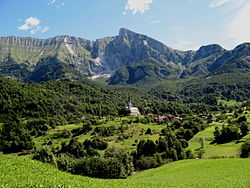Drežnica, Kobarid
- There is also a village in Herzegovina called Gornja Drežnica on the Drežanka river. The train station there is called Drežnica
Drežnica | |
|---|---|
 | |
| Country | |
| Region | Slovenian Littoral |
| Municipality | Kobarid |
| Area | |
| • Total | 2.16 km2 (0.83 sq mi) |
| Elevation | 540.7 m (1,774.0 ft) |
| Population (2002) | |
| • Total | 256 |
| [1] | |
Drežnica (Italian: Dresenza) is a village in the Kobarid municipality in the Littoral region of Slovenia. It is located above the Soča river in a small plateau under the Krn mountain. Together with the neighboring settlements of Koseč, Drežniške Ravne, Jezerca and Magozd it has around 565 inhabitants.
History
The village was first mentioned in 1324. In 1747, the parish of Drežnica was founded. In the late 19th century and early 20th century, it was a prosperous village with more than 1,000 inhabitants. During that time, the current church was built on the site of a previous, smaller one.
At the outbreak of World War I, most of the inhabitants were evacuated to the interior of the Austro-Hungarian Empire. In the first moths after the Italian attack on Austria-Hungary, the village was occupied by Italian troops and the rest of the inhabitants was sent to internment camps in Italy, where many died of malnutrition and bad conditions. The village was almost completely destroyed during the Battles of the Isonzo, but the church remained completely intact.
After the war, in 1918, it was occupied by Italian troops and annexed to Italy in 1920. Between 1920 and 1941, many locals emigrated abroad, mostly to Argentina and Yugoslavia, and the number of inhabitants dropped significantly. During World War Two, especially after the Italian armistice, the area was an important center of Slovenian partisan resistance. In 1945, it was liberated by the partisans and put under Yugoslav military administration. In September 1947, it was officially annexed to Yugoslavia, and included in the Socialist Republic of Slovenia.
The church
The main attraction in the village is the church, dedicated to the Sacred Heart. It was built on the site of an older building dedicated to Saint Julius. The belfry was only completed in 1986 and is 52 metres high [2]. The paintings inside the church were made during World War Two by the Slovene modernist painters Zoran Mušič and Avgust Černigoj.
References
External links

